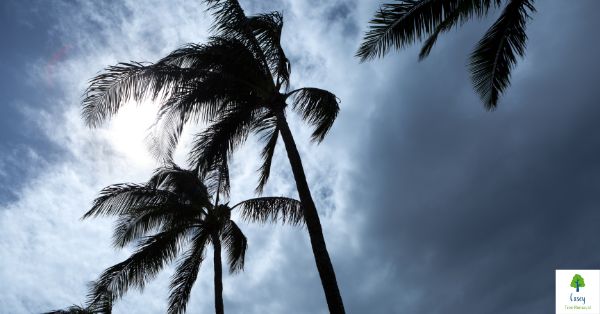Unlike humans, who can (and should) seek shelter during storms, trees can’t take cover – and this leads to tree dangers during and after storms. Of course, storms can happen any time, but the likelihood of tree dangers can escalate during storm season, which, here in Indiana includes mostly spring and summer. Let’s look at some ways storm season might lead to greater tree dangers, and what you can do about it:
Winds
Many storms are accompanied by high winds, sometimes 40, 50, 60 mph or more. And with Indiana tornadoes, those winds can reach over 100 mph! Over time, as branches and limbs dry out or age and die, they become so brittle that they are no match for the winds. But don’t be shocked if even lower speed winds bring down certain limbs and branches. It can be surprising to find your yard littered with tree debris after a “breezy” day, but that is probably a sign your tree is in declining health or at least needs trimmed or pruned so it can be healthier and more resistant to wind damage.
Heavy Rain and Hail
Heavy rain can also bring down tree limbs, especially after an extended dry period. The weight of the water and the constant pounding on the limbs and leaves can cause considerable damage. Hail, obviously, amplifies the danger, with single hail stones capable of bringing down seemingly sturdy branches. And it’s not uncommon to find downed leaves riddled with holes from smaller hail stones. After all, hail doesn’t just drop gently from the sky; the hail stones are often projectiles exerting tremendous force on anything that gets in their way.
Lightning
Electrical storms are particularly frightening, especially for homeowners with tall trees rising above living areas of their homes. Sometimes, older trees survive lightning strikes, but this can make them weaker and more susceptible to falling during future storms. Lightning is a powerful force, indeed. According to Wikipedia, “the heat created by lightning currents traveling through a tree may vaporize its sap, causing a steam explosion that bursts the trunk.” Because of their height, and because they provide a natural “path to ground” for an electrical charge, trees are particularly susceptible to lightning strikes and the resulting damage.
Reducing Tree Dangers
Healthy trees are more resistant to storm damage. Likewise, vibrant branches and limbs are stronger and more likely to withstand high winds, and heavy rain and hail. So, it can be important to keep trees trimmed and/or pruned. “Deadwooding” can also help reduce dangers of falling branches and limbs during or after storms.
When it comes to lightning, trees can be a “sitting duck” in a storm, being a natural attractant to electrical energy seeking a path to ground. Tree height can be an important factor in attracting or avoiding lightning strikes. If your trees are the tallest in your neighborhood, they may be more likely to attract lightning and invite the damage that results. Thus, you might consider having your trees “topped” to both reduce the likelihood of storm damage and enhance their overall health.
Casey Tree Removal – All Tree Services including Tree Cutting, Tree mulching, Tree Trimming, Stump Grinding, Tree Pruning, Stump Removal, Emergency Tree Removal Experts In Melbourne!
Click here to read more articles regarding tree removal & related services.
If you are in Guys Hill, Victoria 3807, and looking for Casey Tree Removal, below is the best way to visit us.


Recent Comments